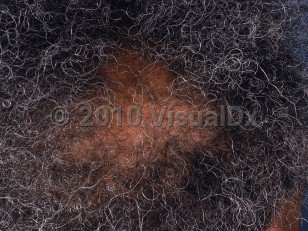Central centrifugal cicatricial alopecia - Hair and Scalp
Alerts and Notices
Important News & Links
Synopsis

Central centrifugal cicatricial alopecia (CCCA), also known as central centrifugal scarring alopecia, is a scarring alopecia predominantly affecting middle-aged women of African descent, with a prevalence of 3%-6% in this demographic.
The exact pathogenesis of CCCA is unknown, but its cause is likely multifactorial. A genetic defect in the internal root sheath in patients of African descent, inherited in an autosomal dominant manner, has been suggested. Mutations in PADI3, which encodes a protein that is essential for normal hair-shaft formation, have been shown to be associated with CCCA. Triggering or aggravation of the disease may then occur following traumatic hair care practices, such as cornrows and braiding, extensions, weaves with sewn-in or glued-on hair, use of hot combs, and frequent use of hair relaxers. Other factors implicated in the pathogenesis, but never conclusively proven, include scalp infections and type 2 diabetes mellitus.
Classically, CCCA presents with progressive hair loss, starting as a single patch at the vertex of the scalp and then expanding in a centrifugal and symmetrical pattern. Unusual variants with multiple irregular patches of hair loss have been described. Although not typical, follicular papules, scaling, erythema, and pustules may occasionally be seen. Initially, scarring may be subtle, but as the disease progresses, it culminates in shiny, scarred plaques. Some residual hairs may be found throughout the involved area.
CCCA is usually symptomatic and may be accompanied by burning, dysesthesia, and/or pruritus.
CCCA was formerly referred to as hot comb alopecia and may also be known as follicular degeneration syndrome, pseudopelade in African Americans, and scarring alopecia in African Americans.
The exact pathogenesis of CCCA is unknown, but its cause is likely multifactorial. A genetic defect in the internal root sheath in patients of African descent, inherited in an autosomal dominant manner, has been suggested. Mutations in PADI3, which encodes a protein that is essential for normal hair-shaft formation, have been shown to be associated with CCCA. Triggering or aggravation of the disease may then occur following traumatic hair care practices, such as cornrows and braiding, extensions, weaves with sewn-in or glued-on hair, use of hot combs, and frequent use of hair relaxers. Other factors implicated in the pathogenesis, but never conclusively proven, include scalp infections and type 2 diabetes mellitus.
Classically, CCCA presents with progressive hair loss, starting as a single patch at the vertex of the scalp and then expanding in a centrifugal and symmetrical pattern. Unusual variants with multiple irregular patches of hair loss have been described. Although not typical, follicular papules, scaling, erythema, and pustules may occasionally be seen. Initially, scarring may be subtle, but as the disease progresses, it culminates in shiny, scarred plaques. Some residual hairs may be found throughout the involved area.
CCCA is usually symptomatic and may be accompanied by burning, dysesthesia, and/or pruritus.
CCCA was formerly referred to as hot comb alopecia and may also be known as follicular degeneration syndrome, pseudopelade in African Americans, and scarring alopecia in African Americans.
Codes
ICD10CM:
L66.8 – Other cicatricial alopecia
SNOMEDCT:
109441000119102 – Central centrifugal cicatricial alopecia
L66.8 – Other cicatricial alopecia
SNOMEDCT:
109441000119102 – Central centrifugal cicatricial alopecia
Look For
Subscription Required
Diagnostic Pearls
Subscription Required
Differential Diagnosis & Pitfalls

To perform a comparison, select diagnoses from the classic differential
Subscription Required
Best Tests
Subscription Required
Management Pearls
Subscription Required
Therapy
Subscription Required
References
Subscription Required
Last Reviewed:07/24/2019
Last Updated:09/28/2022
Last Updated:09/28/2022
 Patient Information for Central centrifugal cicatricial alopecia - Hair and Scalp
Patient Information for Central centrifugal cicatricial alopecia - Hair and Scalp
Premium Feature
VisualDx Patient Handouts
Available in the Elite package
- Improve treatment compliance
- Reduce after-hours questions
- Increase patient engagement and satisfaction
- Written in clear, easy-to-understand language. No confusing jargon.
- Available in English and Spanish
- Print out or email directly to your patient
Upgrade Today


